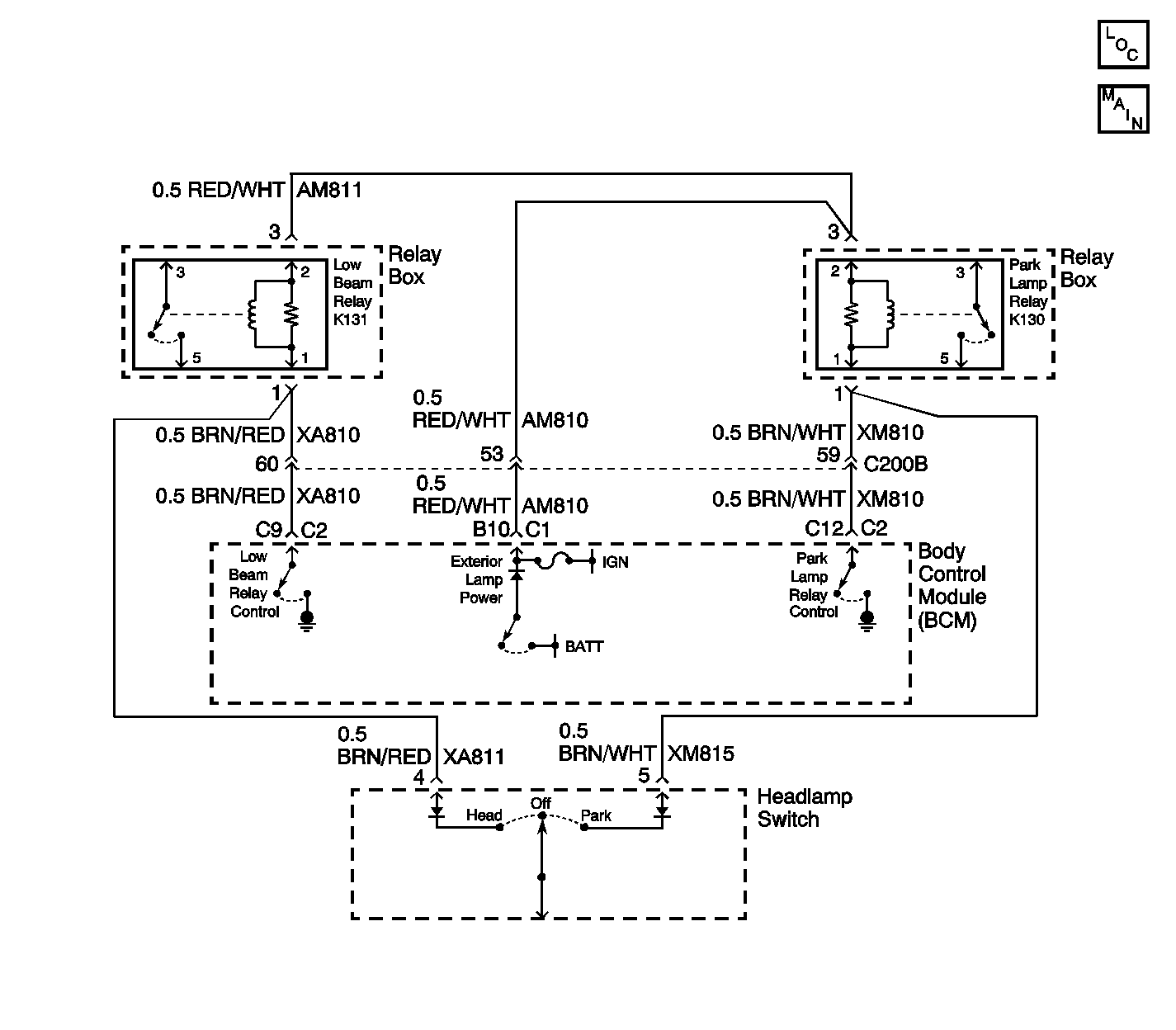
Circuit Description
When the ignition is in the ON position, the body control module (BCM) supplies exterior lamp power to the high side of the low beam relay coil. The BCM grounds the coil at terminal C9, energizing the relay, when the BCM receives an input to turn the low beam lamps ON. This allows battery power to be supplied to the low beam lamps.
Conditions for Setting the DTC
The BCM monitors the output to the low beam relay every second at terminal C9. The criteria for the fault code to set is as follows:
| • | Exterior lamp power is active. |
| • | A DTC B1970 is not set. |
| • | The headlamp switch is inactive. |
| • | The commanded state doesn't match the feedback for 3 seconds (open circuit, short to ground or B+). |
Action Taken When the DTC Sets
| • | The BCM continues to command the requested states until the state is achieved or until the state changes. |
| • | Stores a DTC B2472 in the BCM memory. |
Conditions for Clearing the DTC
| • | The conditions for the fault are no longer present. |
| • | Use a scan tool. |
| • | A history DTC will clear after 50 ignition cycles if the condition for the fault is no longer present. |
Diagnostic Aids
Refer to Power and Grounding Component Views in Wiring Systems for an end view and for terminal assignments of the relay box when the diagnostics direct you to take electrical measurements at the relay box.
Check for the following conditions if a history or intermittent DTC is indicated:
| • | A damaged wiring harness. Inspect the wiring harness for damage. If the wiring harness appears to be in good condition, observe the display on the DMM while moving the connectors and wiring harnesses related to the circuits. A change in the DMM display during this test will indicate the location of the fault. |
| • | For additional information, refer to Intermittents and Poor Connections Diagnosis . |
| • | A short to ground in CKT XA810 may cause the low beams to illuminate at all times with the ignition ON and the headlamp switch in the OFF position. |
Test Description
The following numbers refer to the step numbers on the diagnostic table:
-
This step uses a scan tool to test the low beam operation and to verify if the fault is present.
-
This step tests for an intermittent condition in the circuits that can cause a DTC B2472 to set.
-
After verifying that no circuit problems exist, the BCM is most likely at fault. The BCM needs to be programmed after installation.
Step | Action | Value(s) | Yes | No |
|---|---|---|---|---|
1 | Did you perform the BCM System Check? | -- | Go to Step 2 | |
Did the low beam lamps light when commanded ON? | -- | Go to Step 3 | Go to Step 4 | |
Were any repairs made? | -- | Go to Step 12 | -- | |
4 |
Is the measured voltage at the specified value? | B+ | Go to Step 5 | Go to Step 6 |
5 |
Is the voltage at terminal C9 less than the indicated value? | 1 V | Go to Step 11 | Go to Step 10 |
6 |
Did you find an open circuit? | -- | Go to Step 8 | Go to Step 7 |
7 | Measure the resistance from BCM connector C2 terminal C9 (CKT XA810) to a good ground. Is the measured resistance at the specified value? | OL | Go to Step 12 | Go to Step 9 |
8 | Locate and repair the open circuit in CKTs AM810, AM811 or XA810. Is the repair complete? | -- | Go to Step 12 | -- |
9 | Locate and repair the short to ground in CKTs XA810 or XA811. Is the repair complete? | -- | Go to Step 12 | -- |
10 | Locate and repair the short to B+ in CKTs XA810 or XA811. Is the repair complete? | -- | Go to Step 12 | -- |
|
Important: Perform the set up procedure for the BCM. Replace the BCM. Refer to Body Control Module Replacement . Is the replacement complete? | -- | Go to Step 12 | -- | |
12 |
Did a current DTC B2472 set? | -- | Go to Step 2 | System OK |
